中考英语语法专题讲解——介词(共22张 PPT)
文档属性
| 名称 | 中考英语语法专题讲解——介词(共22张 PPT) |  | |
| 格式 | ppt | ||
| 文件大小 | 3.6MB | ||
| 资源类型 | 试卷 | ||
| 版本资源 | 通用版 | ||
| 科目 | 英语 | ||
| 更新时间 | 2022-04-10 21:57:45 | ||
图片预览


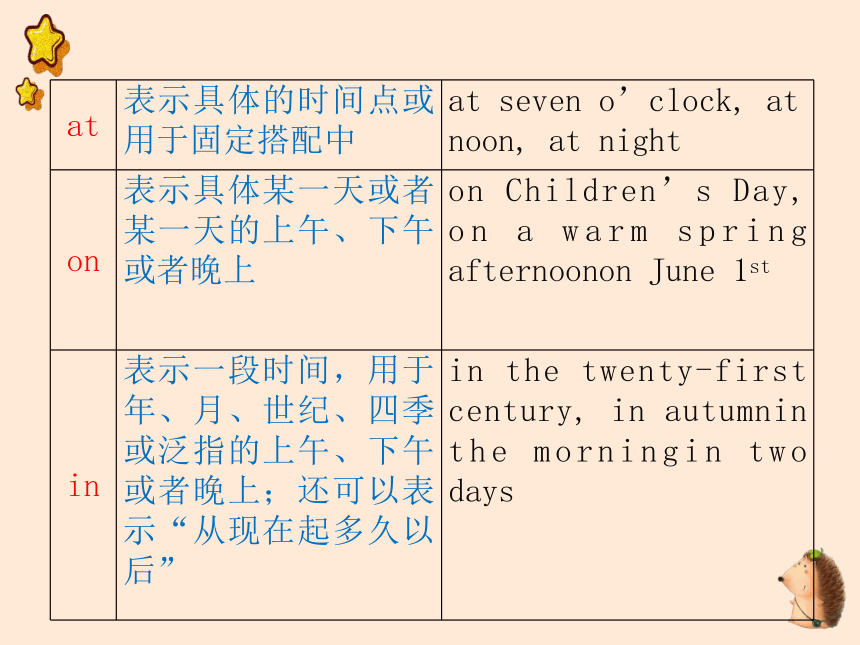

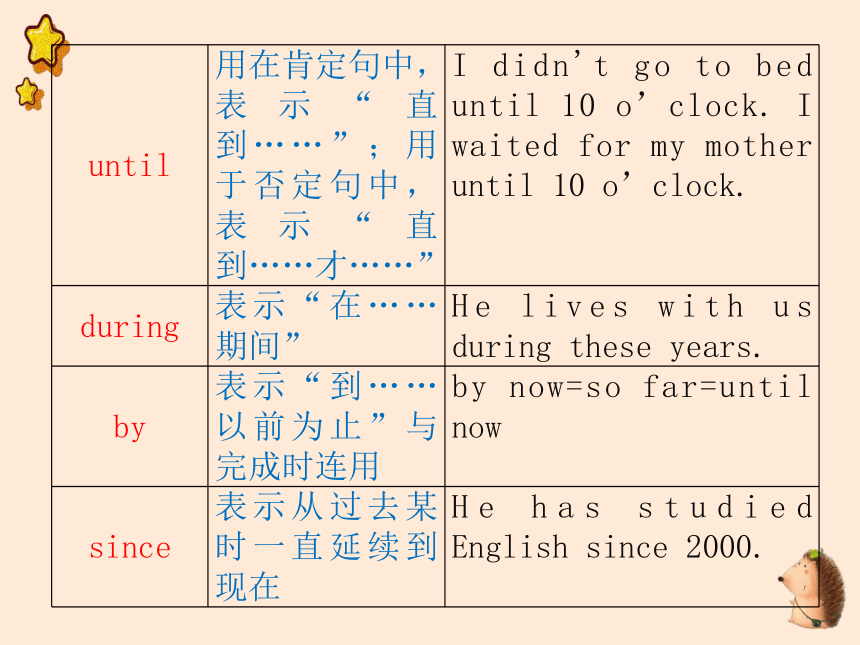
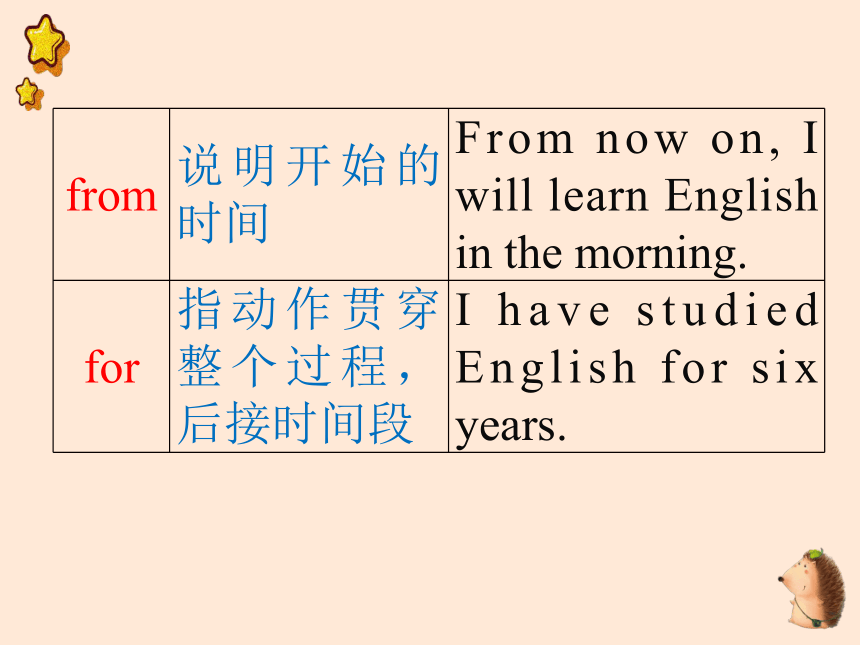

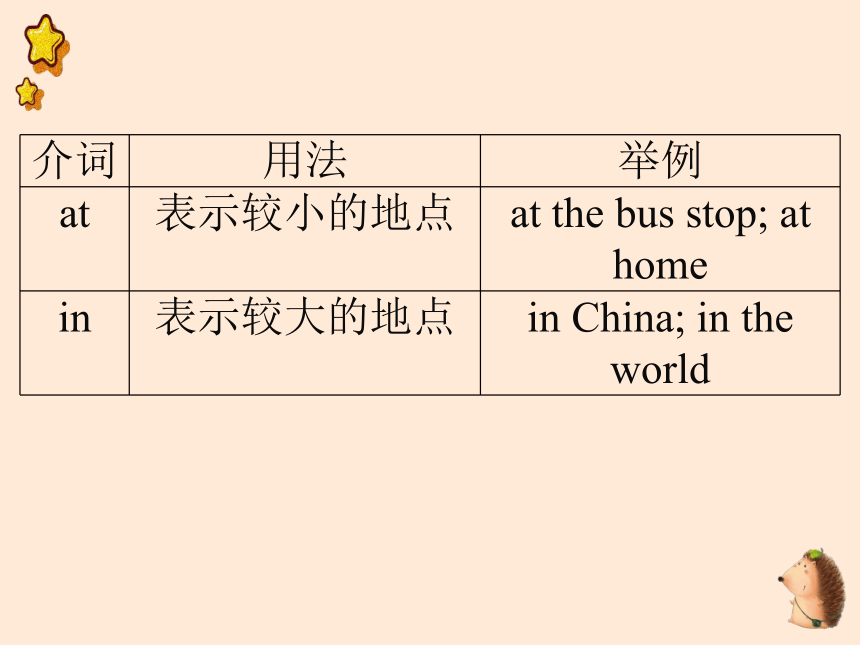
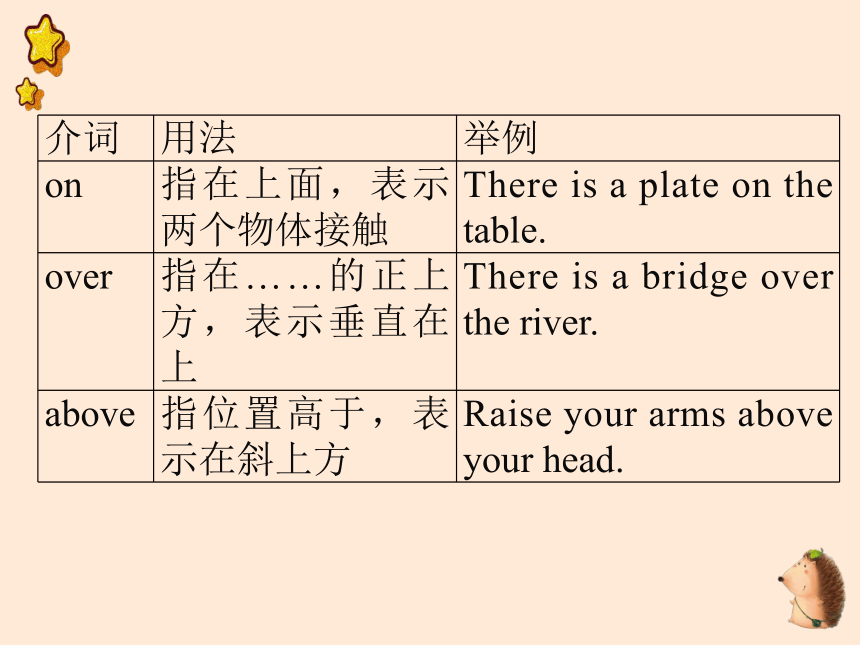
文档简介
(共22张PPT)
中考英语语法专题讲解——介词
at 表示具体的时间点或用于固定搭配中 at seven o’clock, at noon, at night
on 表示具体某一天或者某一天的上午、下午或者晚上 on Children’s Day, on a warm spring afternoonon June 1st
in 表示一段时间,用于年、月、世纪、四季或泛指的上午、下午或者晚上;还可以表示“从现在起多久以后” in the twenty-first century, in autumnin the morningin two days
after
表示以现在或者过去为起点的一段时间之后 They finished the work after two years.I’ll ring you up after two o’clock.
before
在……之前 Please bring your homework before ten o’clock.
until 用在肯定句中,表示“直到……”;用于否定句中,表示“直到……才……” I didn't go to bed until 10 o’clock. I waited for my mother until 10 o’clock.
during 表示“在……期间” He lives with us during these years.
by 表示“到……以前为止”与完成时连用 by now=so far=until now
since 表示从过去某时一直延续到现在 He has studied English since 2000.
from 说明开始的时间 From now on, I will learn English in the morning.
for 指动作贯穿整个过程,后接时间段 I have studied English for six years.
介词 用法 举例
at 表示较小的地点 at the bus stop; at home
in 表示较大的地点 in China; in the world
介词 用法 举例
on 指在上面,表示两个物体接触 There is a plate on the table.
over 指在……的正上方,表示垂直在上 There is a bridge over the river.
above 指位置高于,表示在斜上方 Raise your arms above your head.
介词 用法 举例
in 表示在某一地区内的某方位(属于该范围) Fujian is in the southeast of China.
on 表示与某地的毗邻关系 Taiwan lies to the east of Fujian
to 表示在某一区域之外的某方位(不属于该范围) Mongolia is on the north of China.
介词 用法 举例
in front of 在……之前(范围外) There are trees in front of the room.
in the front of 在……的前部(范围内) There is a desk in the front of the room.
before 表示“在……之前”与in front of相同 He sits before me.
in和on表示“在……上”的区别
介词及短语 用法 举例
in in the tree 表示人或者其它东西在树上 Look! Some birds are singing in the tree.
in the wall 表示门、窗等嵌在墙上 There are three two windows in the wall.
on on the tree 表示果实长在树上 She tried to reach the apples on the tree.
on the wall 表示东西张贴或者挂在墙上 The teacher put up the map on the wall.
between和among的区别
介词 用法 举例
between 两者之间;三者或者以上事物分别看待,指每两者之间 between you and me
between meals
among 表示在三者或者以上之间 among the students
across和through,over和past的区别
介词 用法 举例
across 从表面穿过,横穿马路、河、海等 He can swim across the river.
through 从空间内部穿过 He went through the crowd to get to his son.
over 在空间范围上越过、超过 The plane flew over the mountains.
past 从旁边经过 They walked past a hospital.
after和behind的区别
介词 用法 举例
after 表示时间或者位置之后 They returned after five o’clock. The dog ran after him.
behind 只表示位置之后 The children hid behind the door.
with, by和in表示“用”时的区别
介词 用法 举例
with 表示使用具体的工具 with a knife
by 表示“用……手段或者方式”,后接交通工具名词或者动名词 by bus; by shouting
in 表示使用某种语言 in English
except, besides和but的区别
介词 用法 举例
except 表示“除……之外”,指从整体中排除except所指的人或物 All the students went to the zoo except Jim.
besides 表示“除……之外(还有)”,意思是在原来的基础上加上besides除外的人或物 I have a few good friends besides you.
but 表示“除……之外”,常与表示否定意义的词连用 We can do nothing but wait.
at和to表示行为对象时的区别
介词 用法 举例
at 同某些动词连用,表示攻击的目标,含有恶意 Don't laugh at others. It’s impolite.
to 只表示方向,没有恶意 She came to me and shook my hand.
by, in和on表示旅行方式的区别
介词 用法 举例
by 交通工具名词前不用冠词 by air; by ship
in 用于封闭型交通工具名词前 in a car
on 用于开放或者半开放交通工具名词前 on my bike
in和after的区别
介词 用法 举例
in 表示以此刻为起点将来的一段时间之后,与一般将来时连用 I’ll be back in an hour.
after 表示过去一个时间点之后的一段时间 After two days, he left.
介词to与不定式符号to的区别
to既是介词,又是动词不定式符号。是动词不定式符号时,后面跟动词原形;是介词时,后面跟名词、代词或者动名词。
下列词组中的to都是介词,在使用时应特别注意,如果它们后面跟的是动词,则用动名词形式。
look forward to 盼望;pay attention to注意;get used to习惯于;make a contribution to为……作贡献
中考英语语法专题讲解——介词
at 表示具体的时间点或用于固定搭配中 at seven o’clock, at noon, at night
on 表示具体某一天或者某一天的上午、下午或者晚上 on Children’s Day, on a warm spring afternoonon June 1st
in 表示一段时间,用于年、月、世纪、四季或泛指的上午、下午或者晚上;还可以表示“从现在起多久以后” in the twenty-first century, in autumnin the morningin two days
after
表示以现在或者过去为起点的一段时间之后 They finished the work after two years.I’ll ring you up after two o’clock.
before
在……之前 Please bring your homework before ten o’clock.
until 用在肯定句中,表示“直到……”;用于否定句中,表示“直到……才……” I didn't go to bed until 10 o’clock. I waited for my mother until 10 o’clock.
during 表示“在……期间” He lives with us during these years.
by 表示“到……以前为止”与完成时连用 by now=so far=until now
since 表示从过去某时一直延续到现在 He has studied English since 2000.
from 说明开始的时间 From now on, I will learn English in the morning.
for 指动作贯穿整个过程,后接时间段 I have studied English for six years.
介词 用法 举例
at 表示较小的地点 at the bus stop; at home
in 表示较大的地点 in China; in the world
介词 用法 举例
on 指在上面,表示两个物体接触 There is a plate on the table.
over 指在……的正上方,表示垂直在上 There is a bridge over the river.
above 指位置高于,表示在斜上方 Raise your arms above your head.
介词 用法 举例
in 表示在某一地区内的某方位(属于该范围) Fujian is in the southeast of China.
on 表示与某地的毗邻关系 Taiwan lies to the east of Fujian
to 表示在某一区域之外的某方位(不属于该范围) Mongolia is on the north of China.
介词 用法 举例
in front of 在……之前(范围外) There are trees in front of the room.
in the front of 在……的前部(范围内) There is a desk in the front of the room.
before 表示“在……之前”与in front of相同 He sits before me.
in和on表示“在……上”的区别
介词及短语 用法 举例
in in the tree 表示人或者其它东西在树上 Look! Some birds are singing in the tree.
in the wall 表示门、窗等嵌在墙上 There are three two windows in the wall.
on on the tree 表示果实长在树上 She tried to reach the apples on the tree.
on the wall 表示东西张贴或者挂在墙上 The teacher put up the map on the wall.
between和among的区别
介词 用法 举例
between 两者之间;三者或者以上事物分别看待,指每两者之间 between you and me
between meals
among 表示在三者或者以上之间 among the students
across和through,over和past的区别
介词 用法 举例
across 从表面穿过,横穿马路、河、海等 He can swim across the river.
through 从空间内部穿过 He went through the crowd to get to his son.
over 在空间范围上越过、超过 The plane flew over the mountains.
past 从旁边经过 They walked past a hospital.
after和behind的区别
介词 用法 举例
after 表示时间或者位置之后 They returned after five o’clock. The dog ran after him.
behind 只表示位置之后 The children hid behind the door.
with, by和in表示“用”时的区别
介词 用法 举例
with 表示使用具体的工具 with a knife
by 表示“用……手段或者方式”,后接交通工具名词或者动名词 by bus; by shouting
in 表示使用某种语言 in English
except, besides和but的区别
介词 用法 举例
except 表示“除……之外”,指从整体中排除except所指的人或物 All the students went to the zoo except Jim.
besides 表示“除……之外(还有)”,意思是在原来的基础上加上besides除外的人或物 I have a few good friends besides you.
but 表示“除……之外”,常与表示否定意义的词连用 We can do nothing but wait.
at和to表示行为对象时的区别
介词 用法 举例
at 同某些动词连用,表示攻击的目标,含有恶意 Don't laugh at others. It’s impolite.
to 只表示方向,没有恶意 She came to me and shook my hand.
by, in和on表示旅行方式的区别
介词 用法 举例
by 交通工具名词前不用冠词 by air; by ship
in 用于封闭型交通工具名词前 in a car
on 用于开放或者半开放交通工具名词前 on my bike
in和after的区别
介词 用法 举例
in 表示以此刻为起点将来的一段时间之后,与一般将来时连用 I’ll be back in an hour.
after 表示过去一个时间点之后的一段时间 After two days, he left.
介词to与不定式符号to的区别
to既是介词,又是动词不定式符号。是动词不定式符号时,后面跟动词原形;是介词时,后面跟名词、代词或者动名词。
下列词组中的to都是介词,在使用时应特别注意,如果它们后面跟的是动词,则用动名词形式。
look forward to 盼望;pay attention to注意;get used to习惯于;make a contribution to为……作贡献
同课章节目录
- 词法
- 名词
- 动词和动词短语
- 动词语态
- 动词时态
- 助动词和情态动词
- 非谓语动词
- 冠词
- 代词
- 数词和量词
- 形容词副词及其比较等级
- 介词和介词短语
- 连词和感叹词
- 构词法
- 相似、相近词比较
- 句法
- 陈述句
- 一般疑问句和否定疑问句
- 特殊疑问句及选择疑问句
- 反意疑问句
- 存在句(There be句型)
- 宾语从句
- 定语从句
- 状语从句
- 主谓一致问题
- 简单句
- 并列句
- 复合句
- 主谓一致
- 主、表语从句
- 名词性从句
- 直接引语和间接引语
- 虚拟语气
- 感叹句
- 强调句
- 倒装句
- 祈使句
- 句子的成分
- 句子的分类
- 题型专区
- 单项选择部分
- 易错题
- 完形填空
- 阅读理解
- 词汇练习
- 听说训练
- 句型转换
- 补全对话
- 短文改错
- 翻译
- 书面表达
- 任务型阅读
- 语法填空
- 其他资料
